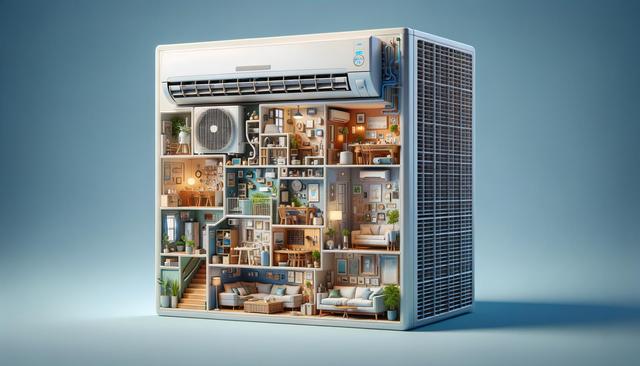What Is a Ductless Air Conditioner?
A ductless air conditioner, also known as a mini-split system, offers a modern solution for cooling individual rooms or zones without the need for traditional ductwork. These systems consist of two main components: an outdoor compressor unit and one or more indoor air-handling units. The indoor units are typically mounted on a wall and are connected to the outdoor component through a small conduit that contains the power cable, refrigerant tubing, and a condensate drain. This design makes ductless air conditioning ideal for homes that lack existing ducts or for new additions where extending ductwork would be expensive or impractical.
Ductless systems are valued for their flexibility and efficiency. They allow homeowners to control the temperature of individual rooms independently, which can lead to significant energy savings. Since they don’t rely on a network of ducts that can leak air, ductless air conditioners often operate more efficiently than central AC systems. In homes where ducts are not present, ductless options provide a practical way to introduce modern climate control without a major renovation.
Energy Efficiency and Cost Savings
One of the most compelling reasons to consider a ductless air conditioner is its potential for energy efficiency and cost savings over time. Traditional HVAC systems can lose up to 30% of energy through leaks in ductwork. By eliminating ducts entirely, ductless systems reduce that energy loss and often result in lower monthly utility bills.
Here are some ways ductless air conditioners help save energy:
- Zone-based cooling allows you to only cool rooms in use
- Inverter-driven compressors adjust performance based on demand
- No energy loss through ducts
- Programmable timers and remote controls increase operational efficiency
Although the initial investment for a ductless system might be higher than a window unit, the long-term savings in energy costs often make up the difference. These systems are also eligible for certain energy rebates and tax credits depending on your region, further enhancing their affordability.
Versatility in Installation and Design
Ductless air conditioners offer unmatched versatility when it comes to installation. Because there is no need to retrofit or build ductwork, they can be integrated into a wide range of spaces. This makes them a practical choice for older homes, room additions, finished basements, garages, or even small commercial spaces.
Some of the installation benefits include:
- Minimal structural impact with small access holes
- Flexible placement of indoor units
- Compact outdoor units that are easy to conceal
- Quick setup compared to traditional systems
Ductless indoor units come in various styles to complement home decor, including sleek wall-mounted versions and ceiling cassette options. The unobtrusive design makes them suitable for both residential and office environments, blending functionality with aesthetics.
Improved Indoor Air Quality
Indoor air quality is a crucial factor in maintaining a healthy living environment, and ductless air conditioning systems can contribute positively in this area. Traditional ducted systems can accumulate dust, allergens, and mold over time, which may then circulate throughout the home. In contrast, ductless systems avoid this issue entirely by not relying on ducts.
Many ductless models also come equipped with multi-stage filtration systems that capture fine particles, allergens, and even odors. Here’s how ductless air conditioners support cleaner air:
- Built-in filters that trap dust and airborne particles
- Reduced circulation of allergens due to lack of ducts
- Easy-to-clean filters that promote regular maintenance
For households with allergy sufferers or individuals sensitive to air quality, a ductless system can offer a noticeable improvement in comfort. Regular maintenance, such as cleaning the filters and scheduling periodic servicing, ensures that the system continues to provide clean, conditioned air efficiently.
Quiet Operation and Enhanced Comfort
Another notable advantage of ductless air conditioners is their quiet operation. These systems are designed to run more quietly than traditional central or window air conditioners. The noisy components, such as the compressor and fan motor, are located outside the living space, contributing to a more peaceful indoor environment.
Benefits of quieter operation include:
- Uninterrupted sleep or work conditions
- Improved comfort during conversations or media use
- Reduced noise pollution in the home
In addition to quiet performance, ductless systems provide precise temperature control. Each indoor unit has its own thermostat, allowing occupants to customize comfort levels room by room. This zoning capability is not only energy-efficient but also ensures personalized comfort for everyone in the household. Whether it’s a bedroom, home office, or living area, each zone can be cooled according to specific needs.
Conclusion: Is a Ductless System Right for You?
Ductless air conditioning systems offer a practical and efficient solution for modern climate control, particularly in spaces where installing ductwork isn’t feasible. With benefits like energy efficiency, improved air quality, flexible installation, and quiet operation, they continue to grow in popularity among homeowners and small business owners alike.
If you’re seeking a way to enhance comfort in your home without the cost and complexity of duct installation, a ductless system might be worth considering. Whether you’re cooling a single room or multiple zones, the adaptability and performance of ductless air conditioning provide a reliable and efficient option for many types of spaces.






